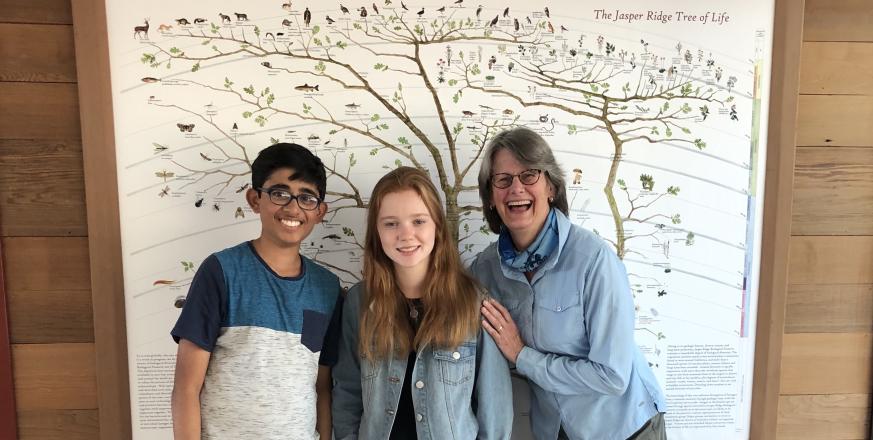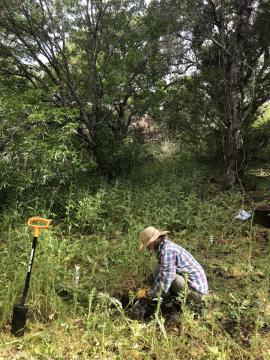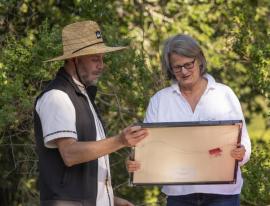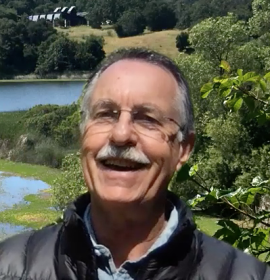Liz Hadly to Step Down from Jasper Ridge Biological Preserve Faculty Directorship

Liz Hadly with Vipulan Puvaneswaran and Bella Lack during filming the documentary ‘Animal’ at Jasper Ridge.
After seven years of guiding Jasper Ridge Biological Preserve as Faculty Director, Liz Hadly will hand over the reins to Tad Fukami on September 1. “It’s been the privilege of a lifetime to have been part of Jasper Ridge over the past few years,” she reflected. “I’ve loved how the place-based learning at Jasper Ridge helps to weave together an understanding of the landscape and its biota, how history sets the future, and how local and global threats are interacting to create the challenges we are facing today in the Anthropocene. Perhaps most importantly I’ve enjoyed seeing how people who really care about a place can make a difference. In these ways, I think that JRBP is a model for nature reserves worldwide.”
During her tenure as leader, Hadly expanded the reach of Jasper Ridge both within the university and globally, guided by a community-developed strategic plan she spearheaded in her first year. An important part of that plan was emphasizing a new pledge for Jasper Ridge: “To be a safe and welcoming place for discovery, discussion, and community for people of all cultures and identities.”
Within the university, she increased the Faculty Advisory Council to include representatives from all of Stanford’s Schools, and highlighted the value of the preserve as a resource for education and research not just for the sciences, but for scholarly activities university-wide. Among the new uses by Stanford students and faculty were an interpretive dance performance, photography and creative writing classes, and musical compositions. Overall, education and outreach visits to the preserve increased by 24% over the years of Hadly’s leadership (from 5100 visits/year in FY16 to 6671/year in FY22, with a peak of 8167/year just prior to the pandemic shutdown), researchers by 31% (from 78/year to 113/year), and research publications by 27% (average of 27/year from FY11 to FY16, to average of 37/year from FY17 to FY22).
Hadly brought Jasper Ridge to the world through highlighting it in such venues as a David Attenbourough documentary, a CBS 60 Minutes feature on the extinction crisis, and the film “Animal,” released at the 2021 Cannes Film Festival (with additional footage taken at Jasper Ridge planned for release in a Netflix series), all of which were filmed in part at Jasper Ridge. Hadly also integrated Jasper Ridge more fully into global biodiversity conservation through fostering international collaborations with conservation organizations in Africa that relied on Jasper Ridge to develop and test field-based conservation technology—for example, her and her students’ pioneering use of eDNA as a means to monitor biodiversity, camera-trap data to reveal ecological cascades, and bringing in dozens of conservation practitioners from around the world to participate in a series of three workshops at Jasper Ridge, funded by the National Science Foundation, that focused on developing conservation technology.
As faculty director, Hadly turned the research focus of her Biology lab towards understanding previously little-studied but key ecological processes at Jasper Ridge, especially in the animal component of the ecosystem. She engaged numerous undergraduate, graduate, and postdoctoral students in projects that used Jasper Ridge to shed light on such diverse topics as ecological network dynamics, ecological cascades, earthworm and arthropod diversity, bat diversity dynamics and diet, mosquito diversity and ecology, E. coli in wild ecosystems, zooarchaeology, taphonomy, biodiversity change through time and across Stanford lands, environmental toxins, palynology and aquatic microfauna, and most recently, work highlighting JRBP as one of only 12 sites worldwide that are defining a whole new geological epoch, the Anthropocene.

Jasper Ridge educational, research, and outreach programs have all benefited from major funding that Hadly raised from the Howard Hughes Medical Institution, the National Science Foundation, and other funding organizations, as well as active advocacy for the preserve to university administration. Her diligence in this regard resulted in adding a new staff scientist position focused on stewardship, developing field-based educational activities that utilize Jasper Ridge, initiating a Jasper Ridge Open House for the broader community, pioneering field-based laboratory tools that democratize molecular biology, enhancing connections with other conservation organizations, initiating a backyard camera-trapping monitoring program for Jasper Ridge neighbors, and developing a co-sponsored Jasper Ridge / Stanford Travel-Study educational trip for Jasper Ridge affiliates and other life-long learners to learn about the wild ecosystems of Botswana and global conservation challenges that Jasper Ridge can help to overcome.
Liz sampling soils to develop a pre-treatment baseline prior to introducing goats and sheep to reduce fire fuels.
As one of her favorite activities at Jasper Ridge, Hadly cites the Jasper Ridge Tree of Life (photo above), which she envisioned after seeing a rendition of a phylogenetic tree illustrating local organisms in Yellowstone National Park, where she has spent over four decades conducting research. The Jasper Ridge Tree of Life became reality through the joint efforts of Hadly, the artist Jennifer Berlinger, and Nona Chiariello, who consulted with many scientists familiar with Jasper Ridge biota to find Jasper Ridge taxa representative of the terminal branches of life’s evolutionary tree. The result—an illustrated, scientifically accurate phylogenetic tree rendered as one of Jasper Ridge’s magnificent oaks— beautifully symbolizes the evolution, ecology, and human stewardship of the landscape that has taken place at the preserve over the past 4.5 billion years.
Hadly effectively guided Jasper Ridge through new challenges during her tenure, notably the pandemic, planning for the Searsville Watershed Restoration Project, and implementing Stanford’s Wildfire Management Plan at the preserve. The Searsville and wildfire projects, as presently conceived, will ultimately affect more than 60% of Jasper Ridge’s lands. Hadly has been a guiding voice for those activities to mimic, as much as possible, the natural ecological processes that Jasper Ridge was set aside to preserve. In the larger picture, in view of these local and the global pressures impacting all ecosystems on Earth, she has also been instrumental in evolving Jasper Ridge’s conservation mission from primarily preservation to active stewardship. Among the innovative ideas she’s introduced are restoring the natural herbivore-vegetation balance at JRBP, not only with domestic animals such as goats and sheep, but also by exploring possibilities for reintroducing a key native herbivore, elk. She presently is working with an interdisciplinary team to understand all the pros and cons of such approaches using community listening sessions, interviews and surveys to learn what interested constituencies and neighbors think.
Next steps for Hadly include taking a long-postponed sabbatical to focus on one of her true loves: embedding herself in nature to pursue curiosity-driven research that also has implications for understanding how to keep our planet healthy in the face of humanity’s pressures. At least one of those projects will keep her as a familiar face at Jasper Ridge. She and her postdoctoral students are using environmental DNA (eDNA) and ancient DNA (aDNA) from Searsville Lake sediment cores to study the so-called Insect Apocalypse at the preserve.
 Hadly’s time at Jasper Ridge was honored at the Biology/Earth Systems 105 graduation ceremony last June, where she was presented a framed photo of a Jasper Ridge landscape taken by acclaimed photographer Joel Simon, who instituted photography classes at Jasper Ridge during Hadly’s time as faculty director. As noted by executive director Jorge Ramos in presenting the photo of sunbeams shining through the oak forest, it represents the qualities that defined Hadly’s leadership: extraordinary vision, strength, and deep appreciation for the wonder of life.
Hadly’s time at Jasper Ridge was honored at the Biology/Earth Systems 105 graduation ceremony last June, where she was presented a framed photo of a Jasper Ridge landscape taken by acclaimed photographer Joel Simon, who instituted photography classes at Jasper Ridge during Hadly’s time as faculty director. As noted by executive director Jorge Ramos in presenting the photo of sunbeams shining through the oak forest, it represents the qualities that defined Hadly’s leadership: extraordinary vision, strength, and deep appreciation for the wonder of life.
Jorge Ramos presenting Liz Hadly a framed photo of Jasper Ridge Biological Preserve. Photo by Robert Siegel.
________________________________________________________________________________________
 Contributed by Anthorny Barnosky, past Executive Director of JRBP.
Contributed by Anthorny Barnosky, past Executive Director of JRBP.



